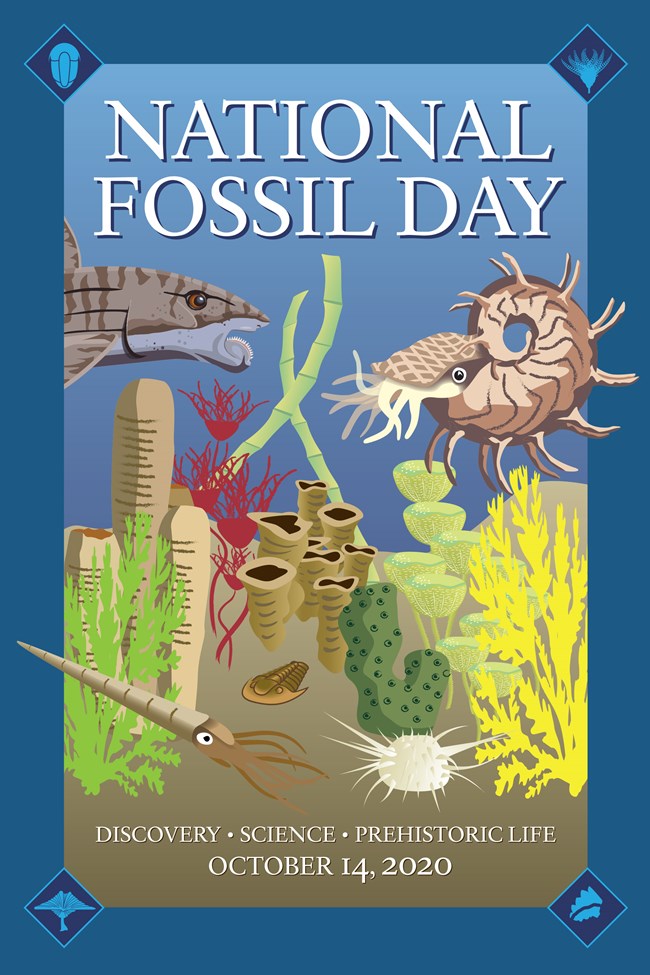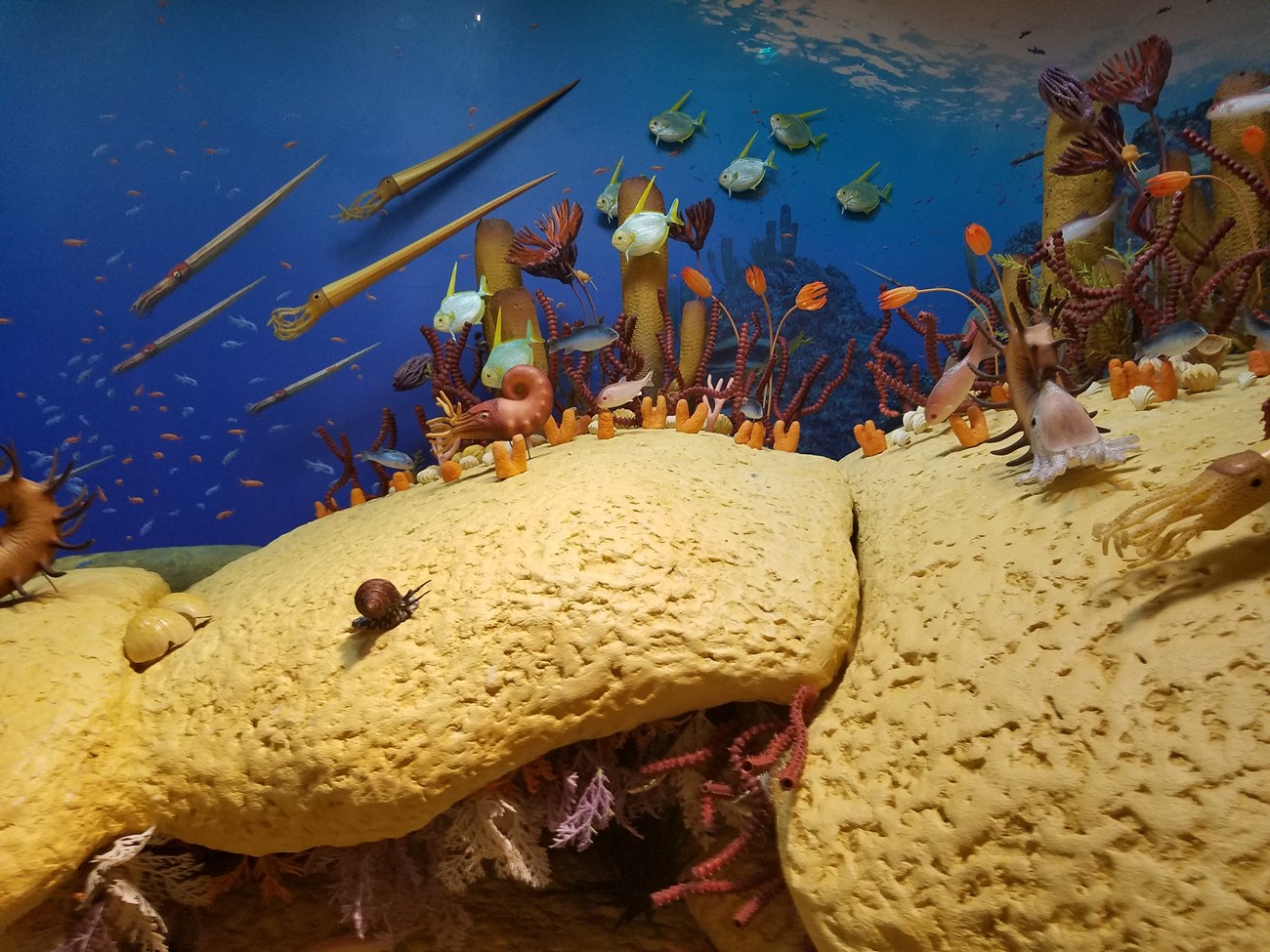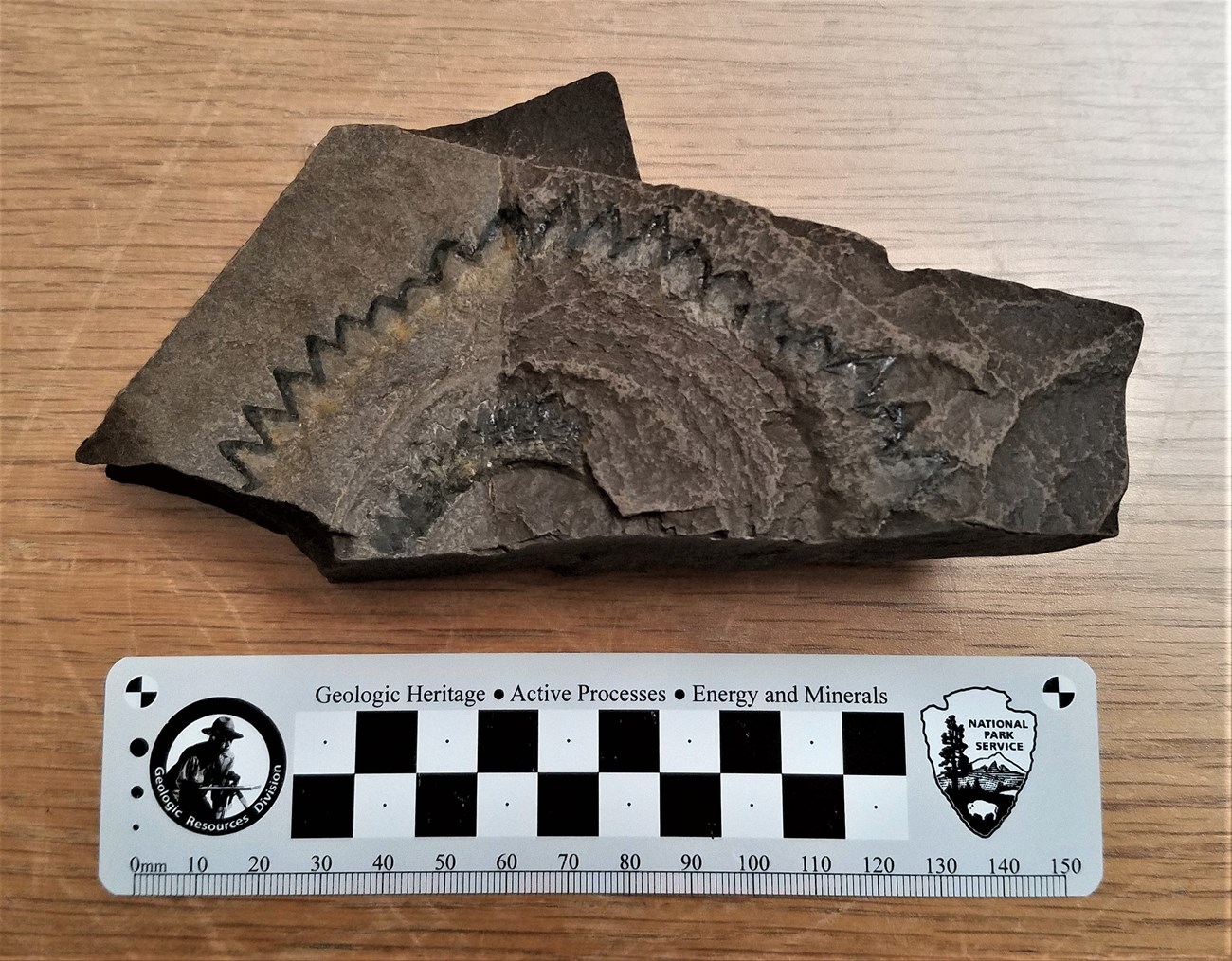Part of a series of articles titled National Fossil Day Logo and Artwork – Prehistoric Life Illustrated.
Article
Fossils of the 2020 National Fossil Day Artwork

Guadalupe and Glass Mountains: 270 Million Year Old Fossil Reef
The 2020 National Fossil Day Logo is inspired by the rich diversity of Permian marine fossils found at the Guadalupe Mountains and Glass Mountains of west Texas and New Mexico. The Permian Period (299 to 252 million years ago) represents the last geologic period of the Paleozoic Era, which ended with a massive extinction event at the boundary marking the end of the Permian and the beginning of the Triassic Period and the Mesozoic Era. During this extinction event approximately 96% of marine species and 70% of terrestrial vertebrate species went extinct. However, the Permian rocks and fossils preserved at Guadalupe Mountains National Park predate this extinction event and shows that a rich tropical reef system once occurred in west Texas and southeastern New Mexico approximately 270 million years ago.
Guadalupe Mountains National Park was established on September 30th, 1972 and incorporates 86,367 acres near El Paso, Texas. The park’s name comes from the Guadalupe Mountains, which are found in western Texas and southeastern New Mexico, and also contain Carlsbad Cavern National Park. Guadalupe Mountains National Park includes Guadalupe Peak, which at 8749 feet in height is the highest point in the state of Texas, and El Capitan, an important geographical feature for travelers of the Butterfield Overland Mail stagecoach line during the late 1800s. These features of the Guadalupe Mountains are composed primarily of fossil-rich Permian limestones. In fact, there are so many fossils in the mountains that the middle part of the Permian is called the Guadalupian.

NPS photo by Vincent Santucci, October 2018.
A Permian Reef: A Home for Animals, Built by Animals
If asked to picture a reef, many people would picture in their mind the Great Barrier Reef off the coast of northeaster Australia. Today, the Great Barrier Reef is the world’s largest coral reef system. The structure of this reef is made up primarily of billions of coral polyps, a group of filter-feeding invertebrate animals that secrete a hard exoskeleton. These exoskeletons are built up in the billions to form massive structures that in turn become the base for other organisms to live around.

The record of the 270-million-year-old ancient reef system preserved in the Guadalupe Mountains shows that this reef was also made up of colonies of invertebrate animals. Invertebrates are animals that do not have the internal structures that form a backbone and frequently form external skeletal structures made of calcium carbonate. Invertebrate animals include corals, sponges, bryozoans, mollusks, worms, arthropods, and jellyfish. However, unlike the Great Barrier Reef which is made primarily of corals, the Permian reef was made by a diversity of other invertebrate animals.
Fossils of Permian corals are preserved in the Guadalupe Mountains and Glass Mountains, but instead of massive colonies, they consisted of single polyps that formed solitary horn-like structures or small colonies that formed small wasp-nest-like colonies. Another group of colonial invertebrate animals found here are bryozoans, which form net-like structures and use ciliated tentacles to sweep water for food particles. Sponge fossils are also well-known from the Permian rocks, with more than sixty species recognized. These are animals that have tube-like to bag-like to flattened bodies and filter food through special pores. Bivalved animals such as clams and brachiopods were dominant components of the ancient reef. Brachiopods in particular are very common at the park and formed massive shell reef beds. Some of the largest species, like the one shown in this year’s National Fossil Day artwork, had specialized spines covering the shell that doubled as protection and as anchors into the sea floor. Unlike clams and their relatives, most brachiopods have a special stalk that attaches to the substrate.
Crinoids, also known as sea lilies, were another major component of the Permian fossil reef system. Crinoids are echinoderms and are related to sea stars and sea urchins, but differ in having a long stalk and a bulb-like structure called a calyx, with many tentacle-like arms. Crinoids use these arms to bring food particles to their mouths which is at the center of the calyx. Fossils of arthropods (crustaceans, insects, arachnids, etc.) are rare but do occur in the Guadalupe Mountains. Of the arthropods, only trilobites are known from the park. Early in the Paleozoic Era, trilobites were a common component from many marine fossil sites. However, by the Permian trilobites were not as common as other arthropods and are rare at most marine sites. Though invertebrate animals make up a major portion of the fossils of the ancient reef, there is also evidence of complex algae, a photosynthetic plant-like organism. The fossils from the park suggest the algae were plant-like with leaf-like and stem-like structures similar to modern kelp.
Shells and Tentacles: The Cephalopods
Free-moving swimming predators such as fish and cephalopods also inhabited the Permian reef. Cephalopods are a group of invertebrates that include octopi and squids which primarily are soft bodied, have multiple tentacles around their oral opening, and use a siphon to propel themselves through the water. During the Permian there were a number of cephalopod species, and many had chambered external shells similar to the modern nautilus. At Guadalupe Mountains National Park, two major groups of shelled cephalopods are known: the ammonoids and the nautiloids. The ammonoids are a well-known group of cephalopods that evolved in the middle Paleozoic Era and survived to the very end of the Mesozoic Era, approximately 66 million years ago. The shells of ammonoids can be either coiled or straight in shape, but the coiled form is more common in Permian rocks. Ammonoids are used extensively by geologists and paleontologists to determine approximate ages of marine sediments around the world because of their abundance and diversity in the fossil record. The nautiloids are another well-known group of shelled cephalopods and are represented today by six species living in the deep waters of the Indo-Pacific oceans. Our 2020 National Fossil Day artwork depicts two types of nautiloids from Guadalupe Mountains National Park. The elaborate coiled nautiloid Cooperoceras is known from the Lower Permian of North America and Europe and bears paired recurved hollow spines along the outer coil. Cooperoceras was probably a slow-moving predator that kept close to the reef to look for prey and used the reef and its spines for protection from larger predators. The other nautiloid depicted has a shell type known as orthoconic, meaning the shell has a long, straight, cone-like form. Orthocones were probably fast-moving predators like modern squids and cuttlefish.

Jaws of the Reef: Sharks and Whorl-toothed Ratfish
The cephalopods of the Permian reef were some of the more common invertebrate predators of their day in the Guadalupe Mountains. Fossil evidence of vertebrates, such as fish, are not well understood from the Permian sediments at this time. However, a group of scientists have produced the remains of small sharks and bony fish from sediment samples taken from the rocks in and around Guadalupe Mountains National Park. Most of their shark fossils represent very small species of primitive sharks, including representatives of the modern shark lineage. A single tooth whorl of a juvenile Helicoprion was collected at Guadalupe Mountains National Park. Helicoprion was a cartilaginous fish that was a close relative of the modern ratfish lineage. Ratfish have been found as fossils going back to the Devonian Period (365 million years ago) and are still alive today in the deep waters of the world’s ocean. Helicoprion had a very specialized single tooth in the lower jaw. This single tooth was continuously growing from a whorl-like tooth root which developed multiple blade-like crowns that do not shed. This is unlike modern sharks which shed their teeth continuously throughout their lives. Paleontologists have theorized that Helicoprion may have specialized in feeding on cephalopods like the ammonoids and nautiloids, using its blade-like tooth whorl to crimp out the soft portion of the cephalopod (the head and tentacles) from the shell. Helicoprion went extinct by the end of the Permian but some of its relatives survived into the early Triassic.
Related Links
Learn more about National Fossil Day and the NFD Logos and Artwork on the official National Fossil Day website.
Guadalupe Mountains National Park—[Geodiversity Atlas] [Park Home] [Park fossil highlights]
Last updated: April 22, 2020
